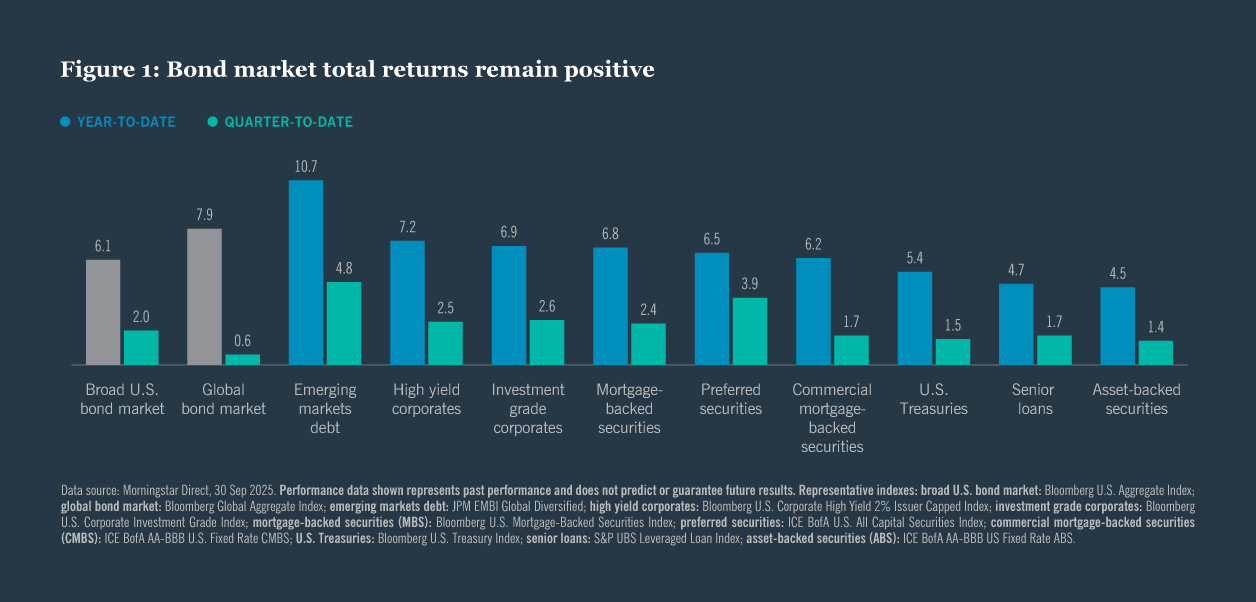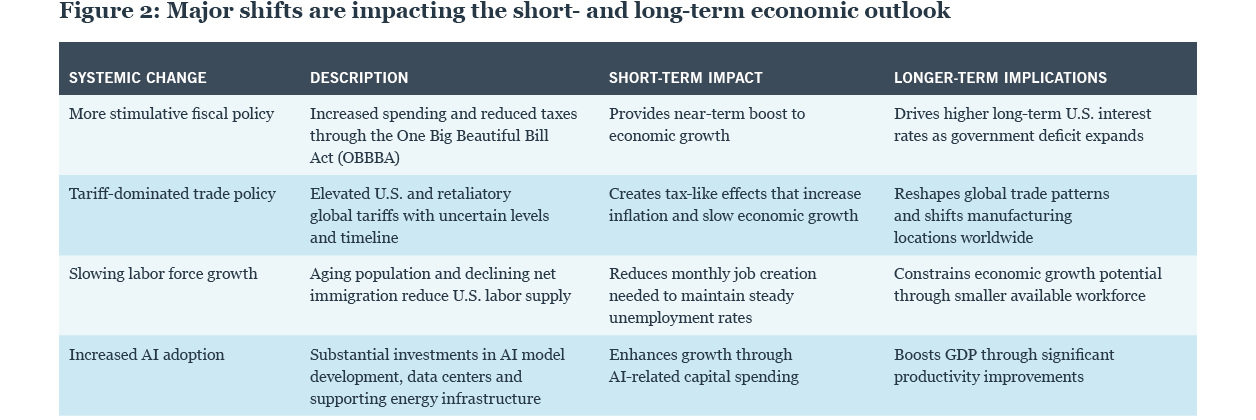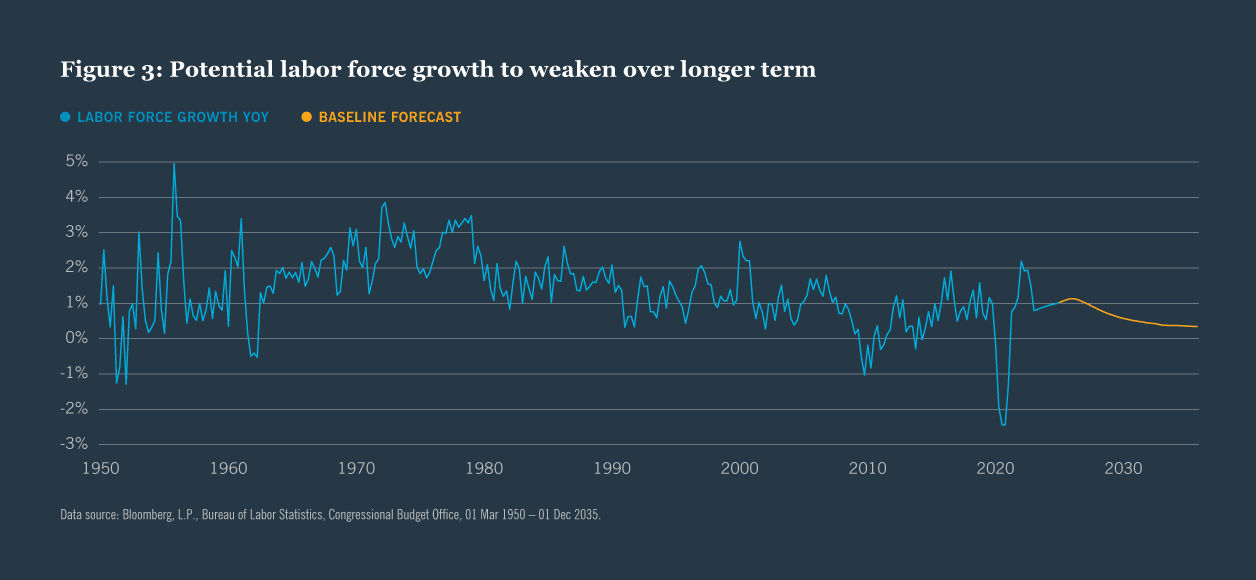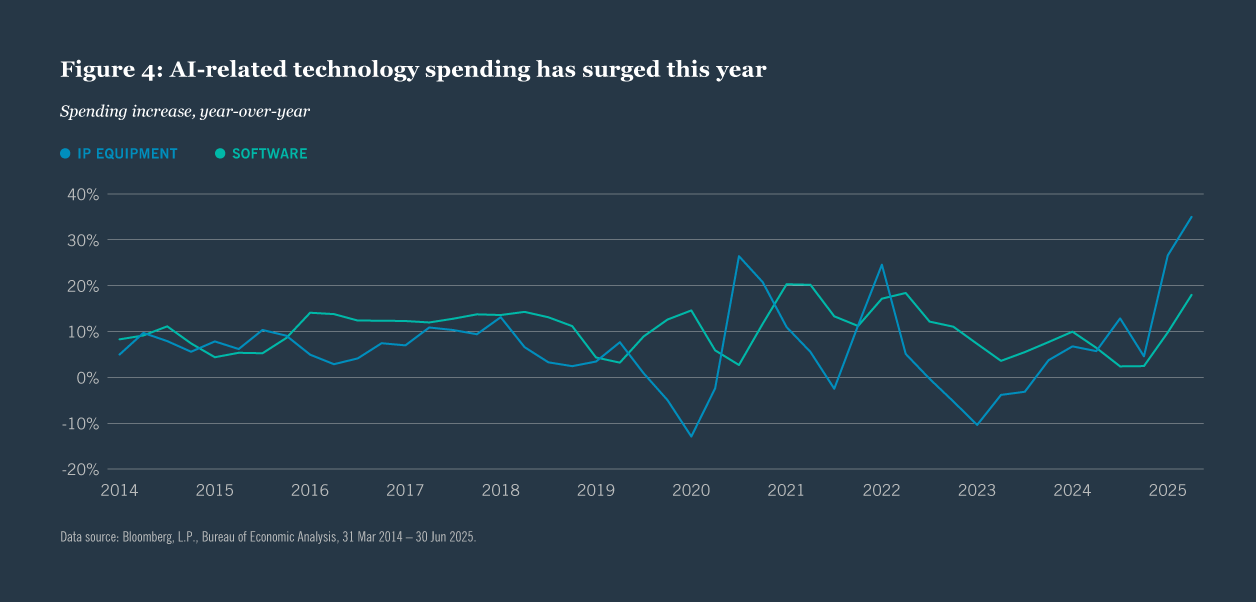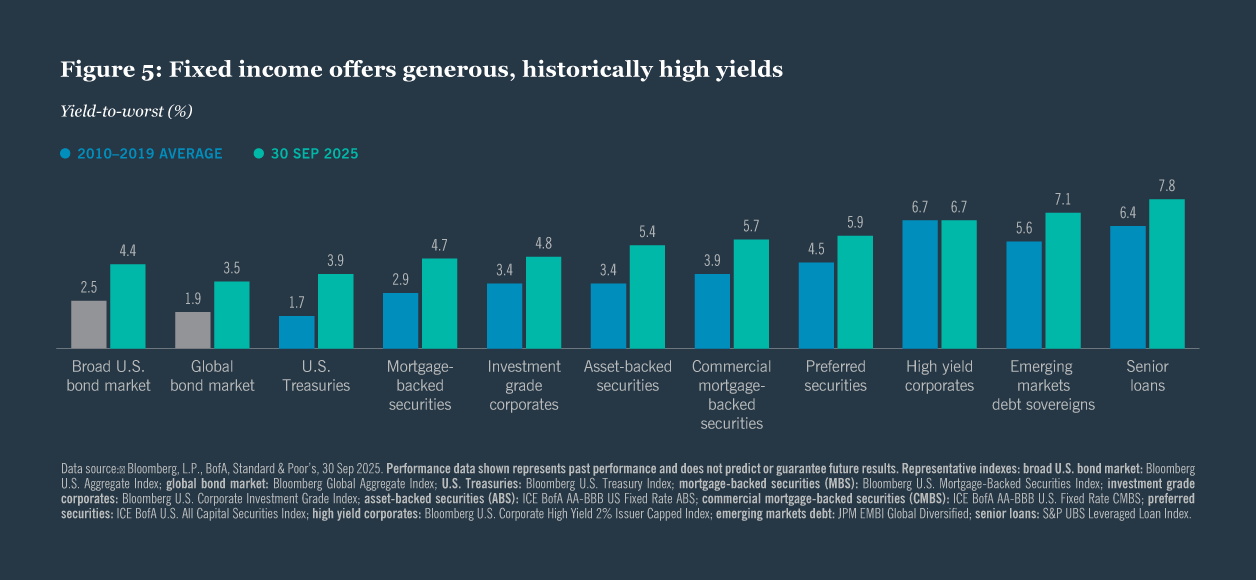
TOOLS
Login to access your documents and resources.
Listen to this insight
~ 16 minutes long
The U.S. economy has undergone major changes in 2025, including stimulative fiscal policy, tariff uncertainty, declining labor force growth and increased AI adoption. These systemic shifts create both opportunities and challenges, accompanied by significant uncertainty. Despite this fluid environment, fixed income markets have delivered strong performance, with all major sectors posting positive returns. Active management may capitalize on emerging opportunities while attractive yields provide stability amid tremendous change.
Key takeaways:
- Four systemic changes — fiscal stimulus, tariffs, declining labor force and AI adoption — are reshaping the U.S. economy with uncertain long-term implications.
- Despite economic uncertainty, all major fixed income sectors posted positive quarterly returns, with many exceeding 6% year-to-date performance.
- We suggest maintaining diversified portfolios with moderate risk posture while emphasizing higher-yielding sectors to capitalize on historically attractive yields and emerging opportunities.
Bond markets deliver strong returns despite economic uncertainty
All major fixed income sectors posted positive returns for the quarter, with year-to-date performance exceeding 6% across many segments (Figure 1). Broadly declining interest rates across the yield curve and sustained investor risk appetite drove this strong performance. Additionally, higher tariffs have not dampened economic growth to the extent many feared earlier in the year. As expected, higher-yielding, non-Treasury spread sectors have outperformed, with emerging markets debt and preferred securities leading the way.
Four systemic changes are reshaping the economy
Since the new administration came into office, the economy and markets have been adapting to systemic changes brought about mainly through policy. We think each of these factors will affect economic growth, interest rates and therefore the fixed income markets. Together, they have created an environment of tremendous uncertainty for consumers, companies, investors and even the policymakers themselves.
While we believe the ultimate results of these historic changes may not be fully revealed for years, some shorter-term and longer-term implications are beginning to come into focus (Figure 2). Because we are still in the early innings, however, it is difficult to predict the effects such large changes may have on the architecture of the economy and markets.
Let’s take a closer look at two of these trends:
Slowing labor force growth
We expect the U.S. workforce to shrink in the coming years due to two primary factors:
Population aging is reducing labor force participation as workers retire or cut back their hours, while declining net immigration reflects stricter immigration policies, fewer undocumented arrivals, and increased enforcement and deportation efforts (Figure 3).
These demographic shifts have dramatically reduced the monthly job creation needed to maintain stable unemployment rates. The threshold dropped from approximately 150,000 jobs per month last year to around 75,000 jobs in September. If net immigration were to reach zero, only 30,000 new jobs monthly would be required to keep unemployment steady.
In the near term, this dynamic means that slower job creation from economic deceleration will not necessarily translate into higher unemployment or increased labor market slack. This could prompt the Federal Reserve to moderate its rate-cutting pace, since achieving maximum employment remains part of its dual mandate. Fewer rate cuts would sustain higher interest rates and bond yields for an extended period, providing continued support for fixed income markets.
Over the longer term, however, slower labor force growth poses a drag on U.S. GDP expansion, as labor is a key driver of economic output. Current estimates suggest that reduced labor force growth will weaken potential GDP growth by approximately 0.8% per year.
Increased AI adoption
The surge in artificial intelligence adoption has predictably driven massive investment in AI technology, data centers, supporting infrastructure, and the energy required to power it all (Figure 4). This AI-related spending has already provided a measurable boost to headline GDP growth — we estimate that in the first half of 2025, GDP growth was approximately 0.3% higher than it would have been without these AI investments.
More intriguingly, AI is creating entirely new investment opportunities within fixed income markets. Asset-backed securities tied to revenue streams from fiber optic networks, data centers and cell towers that handle AI’s massive data processing demands are becoming increasingly common. AI’s substantial power requirements are driving demand for bonds issued by utilities and energy companies expanding grid capacity to meet this demand. Many of these are issued through the emerging hybrid corporate bond market, which has grown significantly to finance these infrastructure projects. We expect AI’s influence to expand across many more segments of the fixed income universe over time.
Looking ahead, widespread AI adoption should materially boost productivity growth, translating into higher overall GDP growth. We currently estimate at least a 0.2% annual increase over the longer term, with upside potential reaching 0.6%. This productivity enhancement could help counterbalance the drag from slowing labor force growth, demonstrating the complex interplay among these transformative economic forces.
Assess economic uncertainty amid policy shifts
The cumulative impact of these policy shifts will undoubtedly drive structural changes in the U.S. economy over time. However, as the examples above demonstrate — with some factors potentially slowing long-term growth while others may accelerate it — the economic trajectory remains far from certain. We believe the most apparent immediate consequence of these changes has been heightened uncertainty across all stakeholders: investors, companies, policymakers and consumers.
Despite this uncertainty, economic growth continues, albeit at more modest levels. In the near term, we expect U.S. GDP growth to decelerate to 1.5% in 2025 before recovering to approximately 1.75% in 2026. Following the Fed’s first rate cut in September, we currently forecast one additional 25 basis point reduction this year and two more 25 basis point cuts in 2026, though one of the 2026 cuts could potentially occur in 2025.
Fiscal stimulus from new policies will provide economic support, reducing pressure for additional monetary easing. Simultaneously, we anticipate longer-term interest rates will remain elevated, reflecting concerns about expanding budget deficits as spending increases and tax cuts take effect.
Uncover hidden value through bottom-up fixed income sector research
Across bond markets, these systemic changes are creating distinct opportunities and challenges for specific sectors. Through fundamental credit research, active management can identify, analyze, and capitalize on these dynamics. Consider these examples:
- Emerging markets present selective opportunities as certain economies stand to benefit from evolving trade policies. We favor South Korea for its existing U.S. trade agreement, economic resilience and positioning within manufacturing supply chains. Brazil appeals for its well-diversified economy with opportunities in corporates, quasi-sovereigns and sovereigns. Mexico offers advantages through its strategic alignment with the U.S. on trade, immigration and security matters.
- Securitized sectors offer compelling prospects, particularly asset-backed securities tied to revenue streams from fiber optic infrastructure, data centers and cell towers that support the expanding data demands of artificial intelligence applications.
- Corporate credit sectors face divergent paths. Packaging, paper, retail and chemicals may experience headwinds from tariff policies, while slower labor force growth could challenge labor-intensive industries including construction, hospitality, agriculture and home health care as they struggle with staffing constraints. Conversely, AI advancement creates opportunities for companies supplying semiconductor manufacturing systems, cloud computing networking services, wireless data transmission and midstream energy production.
- Rate-sensitive sectors will experience varied impacts from the interest rate environment. Steady and possibly rising longer-term rates may pressure longer-duration sectors like investment-grade corporates, particularly given tight credit spreads offer limited downside protection.
However, shorter-term securities are positioned to benefit from Fed rate cuts. Despite anticipated cuts, we continue to believe senior loans and CLOs can deliver attractive total returns given solid fundamentals and favorable technicals.
Navigate fixed income markets with three strategic pillars
At the portfolio level, we believe three key principles are essential in today’s evolving market environment:
Maintain broad diversification. Diversification across and within sectors provides exposure to multiple return drivers, helping mitigate the potentially negative impact of any single variable on overall portfolio performance. While certain market segments may benefit from current changes, the high level of uncertainty makes spreading risk across multiple areas prudent.
Adopt a moderate risk posture. We suggest avoiding overly defensive or aggressive positioning, allowing portfolios to capture upside potential while mitigating downside risks. This balanced approach also preserves adequate capacity within overall portfolio risk budgets to capitalize on market dislocations should they emerge.
Harness the power of higher starting yields. We continue to emphasize higher-yielding, non-Treasury sectors across portfolios, with an up-in-quality bias within each asset class. Historically, starting yields have been the primary driver of fixed income returns. By securing attractive yields today, investors can reduce uncertainty caused by market volatility. Current yields remain elevated relative to historical norms, and the expected gradual pace of Federal Reserve rate cuts should keep them elevated for an extended period (Figure 5). This yield cushion can also help offset potential downside risks from widening credit spreads.
Consider these well-diversified strategies
Multisector fixed income strategies offer an efficient vehicle for accessing our preferred sectors through professional active management. These portfolios provide dynamic allocation across fixed income sectors, with managers adjusting positioning in response to shifting economic conditions and market opportunities.
Short-term bond funds. Broadly diversified, primarily higher-quality securities with low sensitivity to interest rates. They offer an excellent first step for transitioning back into bond markets from cash positions, particularly as yields on cash equivalents are expected to decline with continued Fed rate cuts.
Multisector bond funds. Broadly diversified, multisector bonds across investment grade and below investment grade securities offering potential for high income and reduced interest rate sensitivity.
Core plus funds. Traditional U.S. fixed income with up to 30% in higher yielding plus bond sectors, which provide diversification and potential for additional return.
Core impact funds. Core U.S. fixed income focused on impact and ESG leadership with goal of providing favorable returns versus the broad bond market.
Outlook
Position for measured growth and targeted credit exposure
We have revised our 2025 forecasts upward, projecting U.S. real GDP growth of 1.5% and core PCE inflation of 3.2%. These adjustments primarily reflect tariffs’ slower-than-expected transmission to the broader economy. The inflationary impact has been more modest than initially feared, placing less pressure on consumer spending. However, we still anticipate tariff-related costs will eventually pass through almost entirely to consumer prices, leaving our 2026 outlook largely intact.
We expect the Federal Reserve to continue rate cuts but at a more gradual pace, forecasting one additional 25 basis point reduction this year and two cuts in 2026. Risk exists that one 2026 cut could advance into 2025. The European Central Bank will likely remain on hold through year-end. Increasingly supportive fiscal policy in both economies should reduce pressure on central banks for additional easing in 2026. In China, policymakers will probably maintain fiscal support while avoiding substantial monetary accommodation.
We maintain a modest preference for spread sectors and credit risk in asset allocation, emphasizing higher quality within each asset class. Credit spreads should remain volatile in coming months, potentially creating more attractive entry opportunities. Currently, we identify compelling prospects in securitized markets, particularly commercial mortgage-backed securities and collateralized loan obligations. In addition, we see attractive opportunities in certain emerging markets countries. Treasury yields are expected to finish the year near current levels.
Related articles
The Treasury curve steepened following Fed's rate cut as credit sectors softened, though municipals stayed resilient on strong demand.
Recent federal Medicaid cuts, state budget impasses and tax restructuring are creating varied credit pressures across hospitals, local governments, and housing finance agencies.
Find out what is driving opportunities for taxable municipal bonds as we near the tail end of 2025.

Endnotes
Sources
Inflation: U.S. Bureau of Labor Statistics Consumer Price Index for All Consumers. Employment: Bloomberg, L.P., Bureau of Labor Statistics, Nuveen. Global debt and yields: Bloomberg, L.P.
This material is not intended to be a recommendation or investment advice, does not constitute a solicitation to buy, sell or hold a security or an investment strategy, and is not provided in a fiduciary capacity. The information provided does not take into account the specific objectives or circumstances of any particular investor, or suggest any specific course of action. Investment decisions should be made based on an investor’s objectives and circumstances and in consultation with his or her financial professionals.
The views and opinions expressed are for informational and educational purposes only as of the date of production/writing and may change without notice at any time based on numerous factors, such as market or other conditions, legal and regulatory developments, additional risks and uncertainties and may not come to pass. This material may contain “forward-looking” information that is not purely historical in nature. Such information may include, among other things, projections, forecasts, estimates of market returns, and proposed or expected portfolio composition. Any changes to assumptions that may have been made in preparing this material could have a material impact on the information presented herein by way of example. Performance data shown represents past performance and does not predict or guarantee future results. Investing involves risk; principal loss is possible.
All information has been obtained from sources believed to be reliable, but its accuracy is not guaranteed. There is no representation or warranty as to the current accuracy, reliability or completeness of, nor liability for, decisions based on such information and it should not be relied on as such. For term definitions and index descriptions, please access the glossary on nuveen.com. Please note, it is not possible to invest directly in an index.
Important information on riskInvesting involves risk; principal loss is possible. Debt or fixed income securities are subject to market risk, credit risk, interest rate risk, call risk, derivatives risk, dollar roll transaction risk, and income risk. As interest rates rise, bond prices fall. Foreign investments involve additional risks, including currency fluctuation, political and economic instability, lack of liquidity, and differing legal and accounting standards. These risks are magnified in emerging markets. Preferred securities are subordinate to bonds and other debt instruments in a company’s capital structure and therefore are subject to greater credit risk. Certain types of preferred, hybrid or debt securities with special loss absorption provisions, such as contingent capital securities (CoCos), may be or become so subordinated that they present risks equivalent to, or in some cases even greater than, the same company’s common stock. Asset-backed and mortgage-backed securities are subject to additional risks such as prepayment risk, liquidity risk, default risk and adverse economic developments. Non-investment-grade and unrated bonds with long maturities and durations carry heightened credit risk, liquidity risk, and potential for default.
CFA® and Chartered Financial Analyst® are registered trademarks owned by CFA Institute.
Nuveen, LLC provides investment solutions through its investment specialists.
This information does not constitute investment research as defined under MiFID.
